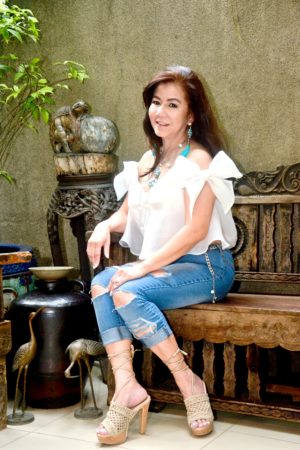INSIDE the residence of Ditas Rodriguez is a pull-push of two forces that are odd together.
What renders the illumination throughout the low-ceiling living room is the afternoon sunlight absorbed in the indoor pocket garden.
Shadows of her antique collection mute the blinding effect: Carved images of saints assigned on consoles, piping a long stretch of daybed.
Only glimmers of light pass through the panels of glass French walls that provide a peer into a menagerie of plants in the front yard.
She lives in a frontier in the blood stream of the noisy Capitol area.
A steel Mandarin lantern hovers on one side of the entire vintage assembly, like earrings that complete a whole… Ditas Rodriguez outfit.
“Do you like it?” she catches us staring intently at the old chandelier.
She descends from a wooden stairwell from a compound of bedrooms, wearing a woven fiber off-the-shoulder blouse with ribbon puffs on the
sides.
A pair of distressed jeans make the ensemble accessible, a cordial act against rumors that she is one of the most expensive fashion designers in Cebu.
“No, no, I am not very expensive—naa pa’y mas mahal nako,” she bursts in laughter.
She’s just too shy to reconcile with milestones she has provided this generation of designers.
A founding member of the Fashion Council of Cebu, Ditas belongs to the first roster of fashion designers in the city.
The next four months of her life will be spent to celebrate her 30th anniversary this year.
She is still a force to reckon with.
In 2007, she debuted a new series of evening gowns during the 12th Association of Southeast Asian Nations.
All sold out, not one has been kept for archive purposes.
Since the 80s, she has been named the queen of fashion in terms of the trends she has launched.
Her kind of beauty supports it, too—tall, slender, long hair, fair skin that were once trails of the modeling career she left in her hometown in Manila.
Numbers no longer count.
She does not rest on any title given to her anymore.
She is content with being the matriarch of this very house, a mother to food entrepreneurs.
Jia, a chef, who runs the pastry shop Got Cake? while older brother Jan owns Ila Puti and The Weekend restaurants.
“I always think I am the odd one in the family. None of my children are interested in fashion. It would have been an easier route for them. They like the food industry. But I cook for my family, too. If you see my siblings, I am the only one who dresses up like this—even my children. Bata pa lang daan, ingun ani na gyud ko,” she says.
Her current atelier protrudes from the main edifice of the house.
“I do not have any dreams for myself anymore. I just want to be here for my children,” she says, promising us that she is not retiring from designing and will be developing more than the visual itch of the job.
Instead, it’s the freedom of artfully arranging something unusual and eclectic to show off one’s own style.
For her, it’s about the high-low, the opposites-attract theory of dressing—a jumble of color and texture, pattern and sparkle.
In a soaring kind of spirit, Ditas just goes with her instincts, best not to ponder it all too much.
What marked your place in the fashion business?
I had a show in Manila in the 80s.
I was pioneering.
I brought with me two assistants, and I had about 140 looks for the collection.
It was a one-woman show.
I had to dress up the models and change them.
For a Cebuano to be in Manila that time was a milestone.
What was your point of entry?
I was already doing womenswear, the conservative designs I already told you.
I used linens.
I wasn’t really into menswear.
I did for close friends, but I did not model my business after it.
In the first place, my husband didn’t want me to entertain male clients.
Was your first encounter with fashion at a design school?
No.
When I was a kid, I was already fond of fashion.
I loved dressing up.
I was seven years old when I already enjoyed getting my own fabric and had it sewn by a sastre.
I made my own style.
I do remember the first design I did, a turtle neck, the tent, and the bell sleeves.
It was more of an abstract.
Most of those working in fashion got their sense from their mothers.
Actually, none in the family.
It’s only in the third generation that the interest in fashion came out—my niece and nephew, diha nangawas ang mga artistic skills
nila.
My siblings?
None.
May actress, may beauty queen (Maxine Medina, Bb. Pilipinas-Universe 2016) lumabas in the third generation.
In my generation, ako ra … kataw-anan kaayo.
What makes your design so timeless?
Di ba pangit sabihin that there’s a touch of class?
I want to go for something simple and elegant.
If you were to speak to an upcoming fashion designer…
This is what I have always mentioned before.
They think naka design lang sila minsan, designer na sila kaagad.
Hindi ganun ‘eh.
At dapat, you have to put your heart in it if you’re designing.
One more, ayaw dauta ang design sa uban.
Dapat meron kang professional ethics.
Other designers have their own creation; they have their own designs.
Just for you to be elevated, you don’t have to pull anybody down.
We should respect.
What about the business side of it?
We always have our peak and lean seasons.
I don’t have June brides.
For me, my peak season starts in September to April.
In the 80s, I never had a lean season.
As early as June, I didn’t accept customers anymore because I was booked for the entire year.
When China-produced garments were slowly distributed, the competition started.
Society has become lenient with dress codes.
In the 80s, people really wore custom-made cocktail dresses or gowns.
They really went to their favorite designers.
Now, they can go to parties in jeans.
Does this harm the fashion community?
Not necessarily.
I understand.
It’s very expensive to have one dress from a designer.
I also understand, however, the artistry and soul that would go into making a piece.
Ngayon, ang hirap na ng pera.
Dati, JS prom lang, ang dami kong orders.
Ngayon, wala na masyado.
They just rent one.
It’s bad for designers because it does not do good to our business, but budget-wise, it’s practical.
If you can’t spare extra money for a custom-made gown, it’s okay to just rent a gown.
How do you describe your personal style?
Actually, some people would misinterpret me for the way I dress up.
But it’s the opposite.
Dress ko lang ‘yan.
I really like sexy clothes.
If your skin is showing somewhere, it should also be covered somewhere.
That’s true—if I’m wearing shorts, I’m all covered up from the waist up.
There’s always a little skin that’s coming out.
I find it sexy.
You’re the queen of seduction. It always shows in your evening dresses.
Confidence is the core of sex appeal.
I am not talking about a certain body type alone.
You could be in any shape.
You have to embrace your body type and learn how to augment it through clothes.
No matter how simple your outfit it if you carry it well, it’s always chic anytime.
Do you think being a woman in design is an edge?
Not necessarily.
The men in fashion design have good concepts.
A few times lang that they could overdo it because their fantasy is interpreted in the process.
Ako as a woman designer, I know how a woman feels in a dress.
We share the same glories and insecurities—Oh, yes.
Designing isn’t just creating beautiful things.
I look at the figure.
I consider the character.
Would you stop designing in the next 30 years?
Malingaw gyud ko.
I would never stop.
It may not be for business anymore but for personal consumption.



